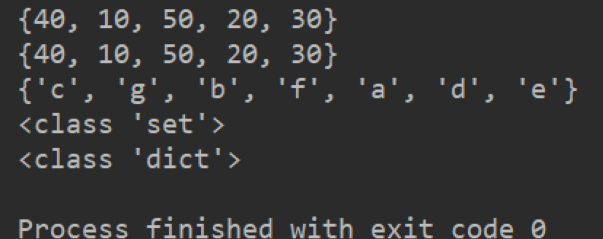集合
# 目标
- 创建集合
- 集合数据的特点
- 集合的常见操作
# 一. 创建集合
创建集合使用{}或set(), 但是如果要创建空集合只能使用set(),因为{}用来创建空字典。
s1 = {10, 20, 30, 40, 50}
print(s1)
s2 = {10, 30, 20, 10, 30, 40, 30, 50}
print(s2)
s3 = set('abcdefg')
print(s3)
s4 = set()
print(type(s4)) # set
s5 = {}
print(type(s5)) # dict
1
2
3
4
5
6
7
8
9
10
11
12
13
14
2
3
4
5
6
7
8
9
10
11
12
13
14

特点:
- 集合可以去掉重复数据;
- 集合数据是无序的,故不支持下标
# 二. 集合常见操作方法
# 2.1 增加数据
- add()
s1 = {10, 20}
s1.add(100)
s1.add(10)
print(s1) # {100, 10, 20}
1
2
3
4
2
3
4
因为集合有去重功能,所以,当向集合内追加的数据是当前集合已有数据的话,则不进行任何操作。
- update(), 追加的数据是序列。
s1 = {10, 20}
# s1.update(100) # 报错
s1.update([100, 200])
s1.update('abc')
print(s1)
1
2
3
4
5
2
3
4
5

# 2.2 删除数据
- remove(),删除集合中的指定数据,如果数据不存在则报错。
s1 = {10, 20}
s1.remove(10)
print(s1)
s1.remove(10) # 报错
print(s1)
1
2
3
4
5
6
7
2
3
4
5
6
7
- discard(),删除集合中的指定数据,如果数据不存在也不会报错。
s1 = {10, 20}
s1.discard(10)
print(s1)
s1.discard(10)
print(s1)
1
2
3
4
5
6
7
2
3
4
5
6
7
- pop(),随机删除集合中的某个数据,并返回这个数据。
s1 = {10, 20, 30, 40, 50}
del_num = s1.pop()
print(del_num)
print(s1)
1
2
3
4
5
2
3
4
5
# 2.3 查找数据
- in:判断数据在集合序列
- not in:判断数据不在集合序列
s1 = {10, 20, 30, 40, 50}
print(10 in s1)
print(10 not in s1)
1
2
3
4
2
3
4
# 三. 总结
创建集合
- 有数据集合
s1 = {数据1, 数据2, ...}1- 无数据集合
s1 = set()1常见操作
- 增加数据
- add()
- update()
- 删除数据
- remove()
- discard()
- 增加数据
""0""
上次更新: 2023/09/05 17:45:42
